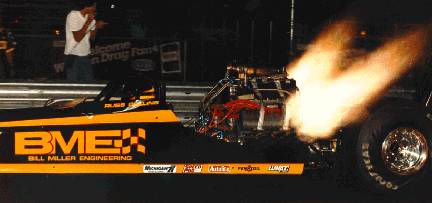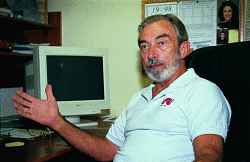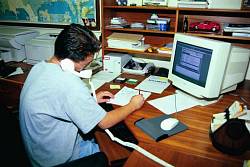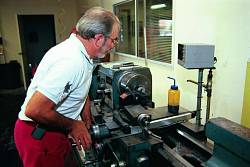RC Fuel Injection, the global leader in electronic fuel injectors for high- performance automotive, motorcycle and marine applications, was started three decades ago by motorcycle racer, Russ Collins. Like many figures in American hot rodding, Russ has a colorful past, but how did someone even the sport of motorcycle racing saw as a bit of a "wild man," end up operating a successful, high-technology business like RC Fuel Injection?
Russ Collins began drag racing motorcycles in the late 1950s. By the mid-60s, he was an authority on high performance motorcycle engines. In 1969, Russ began racing Honda 750s and designed the first, four-into-one motorcycle exhaust header. He started RC Engineering to manufacture that product.
Before the end of the year, he'd set the first ever National Hot Rod Association track record for a Japanese motorcycle and was winning races on RC Engineering-built Hondas at a time when Triumph and Harley-Davidson dominated the sport. Not only was Collins, himself, setting records and winning but so were his customers. Russ Collins became a drag racing legend and RC Engineering became the place to go for high performance parts for Japanese bikes. Its motto was and remains today: "We prove our products in the face of our competitors."
The Revolution in Motorcycle Drag Racing
RC Engineering's reputation for pushing the limits of technology led to the first, successful, blown-injected-on-fuel drag bike. Built in 1971, "The Assassin" weighed a mere 360 pounds and was powered by a 400 horsepower Honda four-cylinder. On The Assassin, Collins set drag race records all over the country. Innovations abounded on that famous bike. It had the first dual- Weber carburetor set-up for a motorcycle and later it was the first motorcycle to use fuel injection and a supercharger together. It was the first Japanese motorcycle to use magneto ignition. It was the first Japanese bike to run on alcohol and nitromethane fuels. By 1973, to beat The Assassin, other racers were forced to use double-engine Nortons, Triumphs and Harley-Davidsons.
Responding to the double-engine "trend", RC Engineering raised the bar another notch. Russ Collins built the "Atchison, Topeka and Santa Fe", a thundering, three-engine, nitromethane-burning, Honda. This frightening machine became the first, seven-second motorcycle in drag racing and the
first Top Fuel bike with a Japanese engine to hold a NHRA National Record. The "AT&SF," also, became the first motorcycle to win NHRA's coveted "Best Engineered Car" award at the Springnationals in 1973.
Russ Collins' three-motor monster eventually ran a best of 7.80 sec./179.5 mph but, in the end, proved a death-defying ride. In 1976, it was destroyed in a horrendous crash at Akron, Ohio that nearly killed Russ, put him in the hospital for several weeks and kept him in a wheelchair for several more. You can't keep a wild man down, though.
While recuperating from the accident, Collins designed the "Sorcerer", his final Top Fuel bike creation. Built in early-1977 and later billed as the World's Greatest Drag Bike, Sorcerer was powered by a pair of 1000cc. Honda fours. This bike won a second NHRA Best Engineered Award for RC Engineering. Blown, injected and running on 90% nitro, this two-wheeled, twin-engined rocket set a world motorcycle acceleration record for the quarter- mile of 7.30 sec./199.55 mph. That mark stood for 12 years, a truly astonishing feat in a sport where records are broken monthly.
In 1980, Russ Collins passed the 200mph drag bike torch to younger competitors. Two were his own employees, Terry Vance and Byron Hines, who raced a RC Engineering-built ,Top Fuel Suzuki. In addition to several event wins, their bike won the company's third NHRA Best Engineered Award. Those two racers went on to success with their own motorcycle business, Vance&Hines.
Russ Collins' ultimate achievement in the motorcycle world came on July 9, 1999 when he was inducted into the American Motorcycle Heritage Foundation's Motorcycle Hall of Fame. Six committees of experts in all areas of motorcycling started with a list of 500 people. Three rounds of balloting reduced that to 72 inductees for 1999 and Collins was one of them. He joins Steve McQueen, J.C. Agajanian, Willie G. Davidson, Evel Knievel, Don Vesco, Malcom Forbes, Bob Hannah, Roger DeCoster and other motorcycling greats as a Motorcycle Hall of Famer.
Turning his driving and engine tuning talents to dragsters, Russ Collins made a deal in 1984 with piston and rod manufacturer, Bill Miller, to drive the Bill Miller Engineering Top Fuel Dragster in NHRA competition. In the late-'80s and early-'90s, driving this 6000 hp. Arias/Chevrolet-powered top fueler, Collins ran a best of 5.03/287. Russ drove the BME car until 1993 when he retired from competition.

Injectors - A New Frontier
 By 1986, the middle classes of showroom stock road racing had become a hot bed of competition favoring small, imported sports coupes-particularly the new, Honda CRX. RC Engineering put its vast experience with Japanese, four-cylinder, race engines to good use setting up a deal with American Honda to become engine supplier to factory-supported Honda teams in the popular SCCA/ESCORT Endurance series, the IMSA Firehawk series and, later, the SCCA World Challenge. Starting in 1986, for eleven straight-years, RC Engineering-powered cars won championships and, in some years, multiple championships culminating with T.C. Kline's North American Touring Car titles in a Honda Accord in 1996 and a BMW in 1997.
By 1986, the middle classes of showroom stock road racing had become a hot bed of competition favoring small, imported sports coupes-particularly the new, Honda CRX. RC Engineering put its vast experience with Japanese, four-cylinder, race engines to good use setting up a deal with American Honda to become engine supplier to factory-supported Honda teams in the popular SCCA/ESCORT Endurance series, the IMSA Firehawk series and, later, the SCCA World Challenge. Starting in 1986, for eleven straight-years, RC Engineering-powered cars won championships and, in some years, multiple championships culminating with T.C. Kline's North American Touring Car titles in a Honda Accord in 1996 and a BMW in 1997.
During that eleven-year period, RC Engineering built or tuned Honda engines as well as BMWs, Chevrolets, Fords, Toyotas, Volkswagens, Mazdas, Mitsubishis and even Kias. They had more wins in road racing (amateur and professional) and in pro rallying than any other engine builder. T.C. Kline, Parker Johnstone, Peter Cunningham, Scott Gaylord, Randy Pobst, Doug Peterson, Lance Stewart and a host of others enhanced their racing careers using RC motors.
 A challenging aspect of building modern race engines, foreign or domestic, is modification of electronic fuel injection systems. The more race engines RC Engineering built, the more Russ Collins learned about electronic fuel injection and, specifically, injectors. In an August 1998 interview for an automotive magazine, Collins told his interviewer, "As I was building motors for Camaros, Mustangs, Hondas and other cars in showroom stock, I found the injectors themselves were an area no one knew anything about. When I was doing Mitsubishi motors for (Dave) Wolin; we were making so much more horsepower than stock, that the injectors became the limiting factor.
A challenging aspect of building modern race engines, foreign or domestic, is modification of electronic fuel injection systems. The more race engines RC Engineering built, the more Russ Collins learned about electronic fuel injection and, specifically, injectors. In an August 1998 interview for an automotive magazine, Collins told his interviewer, "As I was building motors for Camaros, Mustangs, Hondas and other cars in showroom stock, I found the injectors themselves were an area no one knew anything about. When I was doing Mitsubishi motors for (Dave) Wolin; we were making so much more horsepower than stock, that the injectors became the limiting factor.
"We did all we could with pulse width and fuel pressure. I started calling around, asking for information on injectors and nobody knew anything. Obviously, that was the 'black area' of fuel management. As an engine builder, we needed to know more of what we could do with them, how they really worked, how much they would flow and how we could test them.
"We built engines for IMSA and ESCORT guys and, at the race track one day, some guy says, 'I'm gonna put Accord injectors in my Civic. They must be bigger because the Accord motor is bigger.' Well, he tried it and there was no change-the motor didn't run any different. We couldn't call Honda and ask, 'How much do these injectors flow?' Nobody at Honda seemed to know and, if they did, they weren't gonna tell us. After we started flow testing injectors, I found out Honda injectors were virtually all the same. Honda uses different pulse widths and pressures to provide different flow rates.
"At that point, I built my first injector flow bench, which we still use every day, here at RC Fuel Injection. Once we understood how injectors worked and how much they could flow, I realized we could adapt 'larger' ones from other sources to engines that needed more fuel flow.
"That started to open my eyes and we started to think, 'Well, what about these Toyota injectors?' We started testing Toyota, Mitsubishi and Mazda injectors and pretty soon we had a good reference of what the injectors really flowed.
"Now, we can take a higher-capacity, Toyota injector and make it fit a Honda. Same thing with American stuff. We can take a 19 lb (fuel per hour) injector out of a five-liter Mustang, replace it with a 24-lb. injector out of a 350 Chevrolet and have more fuel flow. There are many other, similar upgrade situations like that.
 "To do this, you have to know the part numbers and you have to know the flow rates of all these different injectors. This is what we do, here, at RC Fuel Injection. Through years of exhaustive testing, we have an extensive computer database that covers almost every injector made for every engine. The only injectors we don't have complete flow data for, yet, are the 1998 and later stuff.
"To do this, you have to know the part numbers and you have to know the flow rates of all these different injectors. This is what we do, here, at RC Fuel Injection. Through years of exhaustive testing, we have an extensive computer database that covers almost every injector made for every engine. The only injectors we don't have complete flow data for, yet, are the 1998 and later stuff.
 "Now we had a 'hot rod' injector which was really one designed for some other use, but we didn't stop there. Once motors got bigger and bigger, people started making more power than the biggest production injectors could support. We needed to find out how to take them apart and modify them to flow more. When we learned to do that, we also figured out how to make the spray patterns better, along with a few other tricks."
"Now we had a 'hot rod' injector which was really one designed for some other use, but we didn't stop there. Once motors got bigger and bigger, people started making more power than the biggest production injectors could support. We needed to find out how to take them apart and modify them to flow more. When we learned to do that, we also figured out how to make the spray patterns better, along with a few other tricks."
The Quickest in the World Use RC Injectors
Much of the really exotic injector work RC Fuel Injection does is for serious drag race applications. An example? About the quickest and fastest imported car in the sport is the Mazda R100 of Abel Ibarra. It runs in the low eights at over 170 mph on RC injectors. Vinnie Ten, out of New York, runs the quickest Toyota Supra Twin-Turbo in the country on RC injectors. The fastest Mitsubishi Eclipses in the country all use RC Engineering injectors. Drag race injectors are also available from RC for Buick, Chevrolet, Chrysler and Ford engines.
While RC injectors dominate import drag racing and SCCA World Challenge road racing, Russ Collins' handiwork is not limited to just the race track. The most discriminating enthusiasts of high-performance street vehicles use RC injectors. Be it flow testing and calibrating a set of production injectors or replacing the inadequate stock injectors in a highly modified streeter with a set of higher-flowing and more consistent RC injectors, Russ Collins' shop is the place the street high- performance car buff comes for help.
Vette Magazine, the top monthly publication read by Corvette enthusiasts, built a 1995 ZR-1 project vehicle, billed as the ultimate street-legal, touring car. Vette selected RC injectors. Other magazines, such as Sport Compact Car, Turbo, Street Racer, Super Ford and Super Street have used RC products or service in project cars. RC has done injectors for Corvettes, Vipers, Mustang Cobras, Acura NSXs, RX7 Twin Turbos along with other street-driven, high- performance cars of many different makes and models. RC expertise extends to the highest levels of exotic cars with its injector work on Maseratis and Ferraris.
A Short Tour of RC Fuel Injection
All of this injector magic takes place in RC's relatively modest-sized combination test laboratory and machine shop. Assisted by a staff of three fuel injection technicians and an office manager, Russ Collins turns out the most unique injector work in the world.
RC has not just one but three injector flow testing and calibration systems. Two of them are computer-controlled. One is used to test groups of four very-high-capacity racing injectors simultaneously. The other tests single injectors and also has strobe lights to view injector spray patterns and oscilloscope equipment to analyze injector electrical characteristics. A third injector test bench is used to do basic flow-test work on eight OE or moderate-capacity racing injectors at once.
While RC Fuel Injection has the usual compliment of lathes, mills, drill presses and other machine tools used to manufacture all kinds of custom engine hardware, the most interesting and unusual piece of equipment in Russ Collins' shop is a precision, single-post tool grinder made by the German machine tool firm, Deckel. Deckel precision grinders are rare outside the aerospace industry because of their high cost-
upwards from $25,000-but RC Fuel Injection has one and Russ Collins uses it to work on injector internals. A Deckel is capable of grinding small parts to tolerances of five ten-thousandths of an inch (.0005). When working with parts as small as injector pintels, the operator has to look through a ten- power viewing device, called an optical comparator, while operating the machine.
Computers abound at RC Fuel Injection. Not only are they used to run the office and connect to the Internet, but RC maintains a comprehensive data base of the flow capacity and other characteristics of the hundreds of different types of injectors used world-wide. RC Fuel Injection also maintains a large stock of different types of injectors. With so many injectors on the shelf, computer inventory control is required.